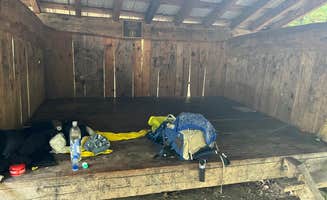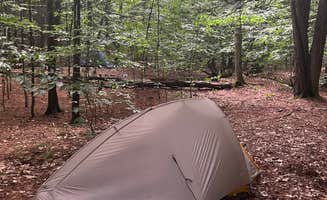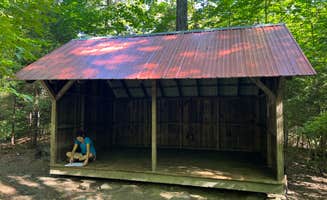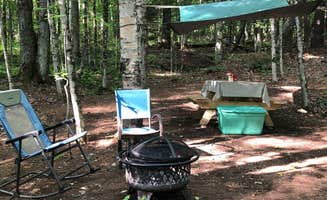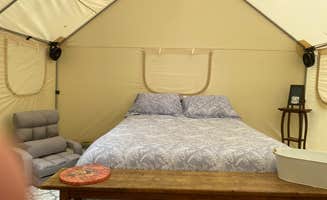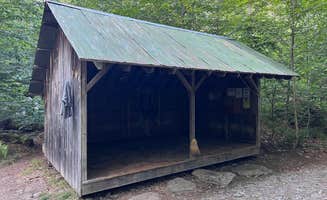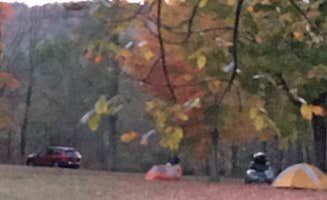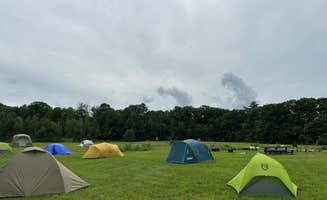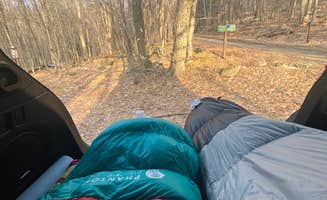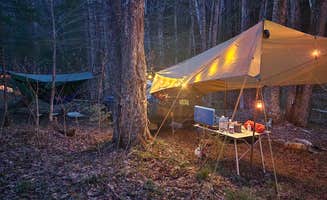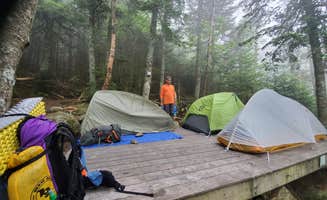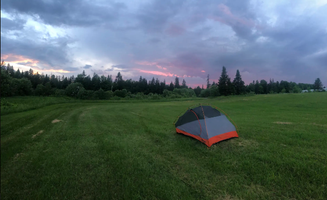The Appalachian Trail near Norwich, Vermont offers primitive tent camping opportunities at elevations ranging from 700 to 1,800 feet. Weather conditions vary significantly with summer highs averaging 75-85°F and frequent thunderstorms, while spring and fall can bring overnight temperatures below freezing. Seasonal access becomes difficult from November through April when snow accumulation makes many approach trails challenging without appropriate winter gear.
What to do
Swimming opportunities: At Stony Brook Backcountry Shelter, campers can find a small swimming hole downstream from the main camping area. "I only explored a bit offtrail down the brook but found a decent swimming hole (could just barely submerge myself) to clean off a bit," notes one AT section hiker, making this a welcome relief during hot summer months.
Fishing access: The Baker Rocks campground provides direct river access for anglers. "I tent camped here while doing some fishing in the area... along another bend of the river were two chairs for taking in the scenery," reports a visitor, though they added they "only caught a few minnows when fishing but that may have been more to do with the angler."
Mountain climbing: Tent campers looking to summit nearby peaks can use Cardigan Campsites as a basecamp. "Great spot to spend the night before a climb of Mt. Cardigan! The climb is challenging but shouldn't take too long. Great fire tower views at the top too!" according to one hiker who used the site as a launching point for their ascent.
What campers like
Shelter designs: Many AT shelters feature unique architectural elements. At Happy Hill Backcountry Shelter, "The shelter had a ground floor and a loft but each floor could maybe fit 4-5 people comfortably... The loft was nice since folks could decide to sleep up there while others were down below, either cooking, arriving, or departing."
Bear protection systems: Some backcountry tent sites offer food storage options. One section hiker noted that Stony Brook Backcountry Shelter "had a bear box here, which I hadn't seen at other shelters along the AT in Vermont (heading southbound)," providing additional security for overnight campers concerned about wildlife encounters.
Site privacy: Tent platforms at certain shelters provide more seclusion than others. At Moose Mountain Backcountry Shelter, "There were a host of large, flat tent sites around the shelter," giving campers options to spread out from the main shelter area.
What you should know
Water reliability: The water sources at most tent campsites near Norwich are highly seasonal. At Moose Mountain Backcountry Shelter, "There can be seasonal water sources but water is not guaranteed," requiring campers to check current conditions or carry adequate water supplies.
Road noise levels: Not all sites provide complete wilderness silence. At Baker Rocks, tent sites are "within the wooded area around the property and felt very secluded. There was a bit of road noise overnight," something to consider for light sleepers selecting a campsite.
Campsite terrain: Tent campers should prepare for variable ground conditions. At Thistle Hill Backcountry Shelter, a hiker noted that it "seemed to have smaller spots for tent camping that were somewhat sloped," highlighting the importance of selecting appropriate tent designs for potentially uneven surfaces.
Tips for camping with families
Glamping alternatives: Families seeking a more comfortable option near tent campsites can consider Baker Rocks' alternative accommodations. "Baker Rocks had a host of different camping options onsite including tent platforms, yurts, and cabins," and another family mentioned, "We stayed 2 nights in the double bell tent with two clean full size beds and a 3rd night in the yurt both were spacious and wonderful, among tall trees and pines."
Insect protection: Parents should pack appropriate repellents for camping with children. At Baker Rocks, one family advised, "Do bring bug spray, the mosquitoes at certain times of day were aggressive, as to be expected," particularly important during summer months when insects are most active.
Animal attractions: Some campgrounds offer additional entertainment for younger visitors. One family camping at Baker Rocks mentioned they "even have animals to visit like bunnies and goats (far away from the campsites)," providing additional activities for children during downtime at camp.
Tips from RVers
Self-contained camping: Most tent campsites near Norwich require complete self-sufficiency. At Trapper John Backcountry Campground, RV campers should note "this is a back country shelter along the AT in New Hampshire so it is entirely hike in," making traditional RV camping impossible but potentially suitable for experienced campers with portable setups.
Minimal facilities: RVers accustomed to hookups will find backcountry sites particularly primitive. Trapper John Backcountry Campground features "a standard 3-sided wooden shelter... with plenty of space for maybe 6-8 folks," but lacks the electrical, water, and sewer connections typically found at developed campgrounds.
Alternative recommendations: RV travelers should consider contacting the Green Mountain Club for information on developed campgrounds near Norwich that can accommodate larger vehicles, as the AT shelters primarily serve hiking-oriented campers with minimal support for motorized camping equipment.


